Comparative Effects of Organic and Conventional Cropping Systems on Trace Elements Contents in Vegetable Brassicaceae: Risk Assessment
Abstract
Featured Applications
Abstract
1. Introduction
2. Material and Methods
2.1. Plant Material
2.2. Materials and Reagents
2.3. Trace Element Determination
2.4. Statistical Analyses and Risk Assessment
3. Results and Discussion
3.1. Trace Element Contents in Brassicaceae Species: Conventional Versus Organic
3.2. Probabilistic Assessment: Conventional Versus Organic
Author Contributions
Funding
Informed Consent Statement
Acknowledgments
Conflicts of Interest
References
- Voorrips, L.E.; Goldbohm, R.A.; van Poppel, G.; Sturmans, F.; Hermus, R.J.J.; van den Brandt, P.A. Vegetable and fruit consumption and risks of colon and rectal cancer in a prospective cohort study—The Netherlands Cohort Study on Diet and Cancer. Am. J. Epidemiol. 2000, 152, 1081–1092. [Google Scholar] [CrossRef] [PubMed]
- Petropoulos, S.A.; Di Gioia, F.; Ntatsi, G. Vegetable organosulfur compounds and their health promoting effects. Curr. Pharm. Des. 2017, 23, 2850–2875. [Google Scholar] [CrossRef] [PubMed]
- Cámara-Martos, F.; Obregón-Cano, S.; Mesa-Plata, O.; Cartea-González, M.E.; de Haro-Bailón, A. Quantification and in vitro bioaccessibility of glucosinolates and trace elements in Brassicaceae leafy vegetables. Food Chem. 2021, 339, 127860. [Google Scholar] [CrossRef] [PubMed]
- Schmidt, R.; Bancroft, I. Genetics and Genomics of the Brassicaceae, 1st ed.; Springer: Berlin, Germany, 2011; pp. 80–81. [Google Scholar]
- FAOSTAT (Food and Agriculture Organization of The United Nation). 2013. Available online: http://faostat3.fao.org/browse/Q/QC/S (accessed on 10 January 2021).
- Avato, P.; Argentieri, M.P. Brassicaceae: A rich source of health improving phytochemicals. Phytochem. Rev. 2015, 14, 1019–1033. [Google Scholar] [CrossRef]
- Rembiałkowska, E. Organic food: Effect on nutrient composition. In Encyclopedia of Food and Health, 1st ed.; Caballero, B., Finglas, F., Toldrá, F., Eds.; Academic Press-Elsevier: Oxford, UK, 2016; pp. 178–180. [Google Scholar]
- Iglesias-Jiménez, E.; Álvarez, C. Apparent availability of nitrogen in composted municipal refuse. Biol. Fertil. Soils 1993, 16, 313–318. [Google Scholar] [CrossRef]
- Kelly, S.D.; Bateman, A.S. Comparison of mineral concentrations in commercially grown organic and conventional crops—Tomatoes (Lycopersicon esculentum) and lettuces (Lactuca sativa). Food Chem. 2010, 119, 738–745. [Google Scholar] [CrossRef]
- Bakkali, K.; Martos, N.R.; Souhail, B.; Ballesteros, E. Determination of heavy metal content in vegetables and oils from Spain and Morocco by inductively coupled plasma mass spectrometry. Anal. Lett. 2012, 45, 907–919. [Google Scholar] [CrossRef]
- Hoefkens, C.; Vandekinderen, I.; De Meulenaer, B.; Devlieghere, F.; Baert, K.; Sioen, I.; De Henauw, S.; Verbeke, W.; Van Camp, J. A literature-based comparison of nutrient and contaminat contents between organic and conventional vegetables and potatoes. Br. Food J. 2009, 111, 1078–1097. [Google Scholar] [CrossRef]
- FESNAD. Ingestas dietéticas de referencia (IDR) para la población española. Act. Diet. 2010, 14, 196–197. [Google Scholar]
- European Food Safety Authority (EFSA). Cadmium in food. EFSA J. 2009, 980, 1–139. [Google Scholar]
- European Food Safety Authority (EFSA). Scientific Opinion on the risks to public health related to the presence of nickel in food and drinking water. EFSA J. 2015, 13, 4002. [Google Scholar]
- European Food Safety Authority (EFSA). Panel on Contaminants in the Food Chain (CONTAM); Scientific Opinion on Lead in Food. EFSA J. 2010, 8, 1570. [Google Scholar] [CrossRef]
- Zaccone, C.; Di Caterina, R.; Rotunno, T.; Quinto, M. Soil—Farming system—Food—Health: Effect of conventional and organic fertilizers on heavy metal (Cd, Cr, Cu, Ni, Pb, Zn) content in semolina samples. Soil Tillage Res. 2010, 107, 97–105. [Google Scholar] [CrossRef]
- Douay, F.; Pelfrêne, A.; Planque, J.; Fourrier, H.; Richard, A.; Roussel, H.; Girondelot, B. Assessment of potential health risk for inhabitants living near a former lead smelter. Part 1: Metal concentrations in soils, agricultural crops, and homegrown vegetables. Environ. Monit. Assess. 2013, 185, 3665–3680. [Google Scholar] [CrossRef]
- Hadayat, N.; De Oliveira, L.M.; Da Silva, E.; Han, L.; Hussain, M.; Liu, X.; Ma, L.Q. Assessment of trace metals in five most—consumed vegetables in the US: Conventional vs. organic. Environ. Pollut. 2018, 243, 292–300. [Google Scholar] [CrossRef]
- Krejcová, A.; Návesník, J.; Jicinská, J.; Cernohorský, T. An elemental analysis of conventionally, organically and self-grown carrots. Food Chem. 2016, 192, 242–249. [Google Scholar] [CrossRef] [PubMed]
- Gosling, P.; Hodge, A.; Goodlass, G.; Bending, G.D. Arbuscular mycorrhizal fungi and organic farming. Agric. Ecosyst. Environ. 2006, 113, 17–35. [Google Scholar] [CrossRef]
- Dogan Uluozlu, O.; Tuzen, M.; Soylak, M. Speciation and separation of Cr(VI) and Cr(III) using coprecipitation with Ni2+/2-Nitroso-1-naphthol-4-sulfonic acid and determination by FAAS in water and food samples. Food Chem. Toxicol. 2009, 47, 2601–2605. [Google Scholar] [CrossRef]
- Saraiva, M.; Chekri, R.; Leufroy, A.; Guérin, T.; Sloth, J.J.; Jitary, P. Development and validation of a single run method based on species specific isotope dilution and HPLC-ICP-MS for simultaneous species interconversion correction and speciation analysis of Cr(III)/Cr(VI) in meat and dairy products. Talanta 2021, 222, 121538. [Google Scholar] [CrossRef]
- Mataix-Verdú, J.; Llopis-González, J. Minerales. In Nutrición y Alimentación Humana. Nutrientes y Alimentos, 2nd ed.; Mataix-Verdú, J., Ed.; Editorial Ergón: Madrid, Spain, 2015; pp. 265–301. [Google Scholar]
- Amari, T.; Lutts, S.; Taamali, M.; Lucchini, G.; Sacchi, G.A.; Abdelly, C.; Ghnaya, T. Implication of citrate, malate and histidine in the accumulation and transport of nickel in Mesembryanthemum crystallinum and Brassica juncea. Ecotoxicol. Environ. Saf. 2016, 126, 122–128. [Google Scholar] [CrossRef]
- Karavoltsos, S.; Sakellari, A.; Dassenakis, M.; Scoullos, M. Cadmium and lead in organically produced foodstuffs from the Greek Market. Food Chem. 2008, 106, 843–851. [Google Scholar] [CrossRef]
- Cámara-Martos, F.; Ramírez-Ojeda, A.; Jiménez-Mangas, M.; Sevillano-Morales, J.; Moreno-Rojas, R. Selenium and cadmium in bioaccessible fraction of organic weaning food: Risk assessment and influence of dietary components. J. Trace Elem. Med. Biol. 2019, 56, 116–123. [Google Scholar] [CrossRef] [PubMed]
- Cámara-Martos, F.; Moreno-Rojas, R. Cobalt: Toxicology. In Encyclopedia of Food and Health, 1st ed.; Caballero, B., Finglas, F., Toldrá, F., Eds.; Academic Press-Elsevier: Oxford, UK, 2016; Volume 2, pp. 172–178. [Google Scholar]
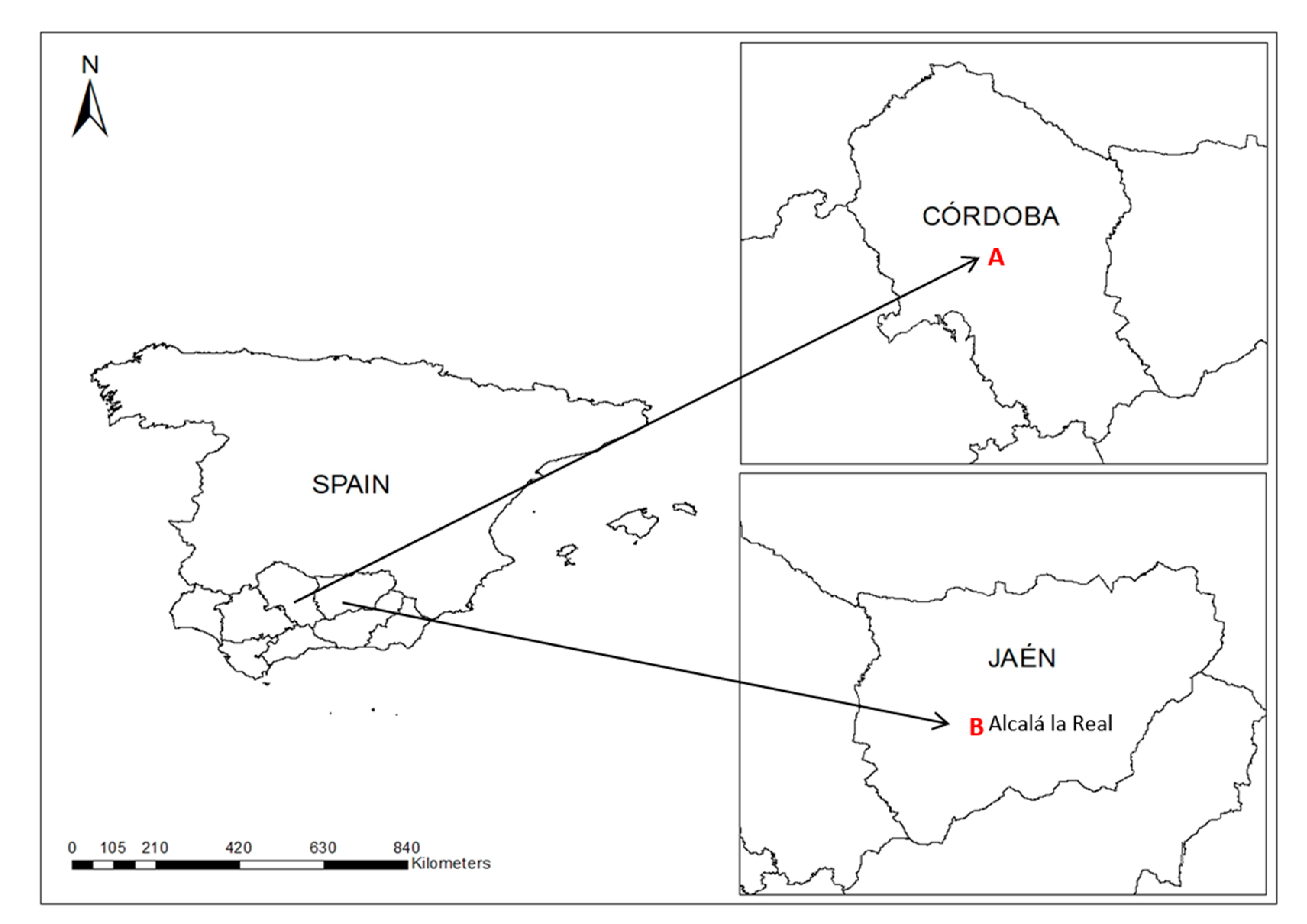
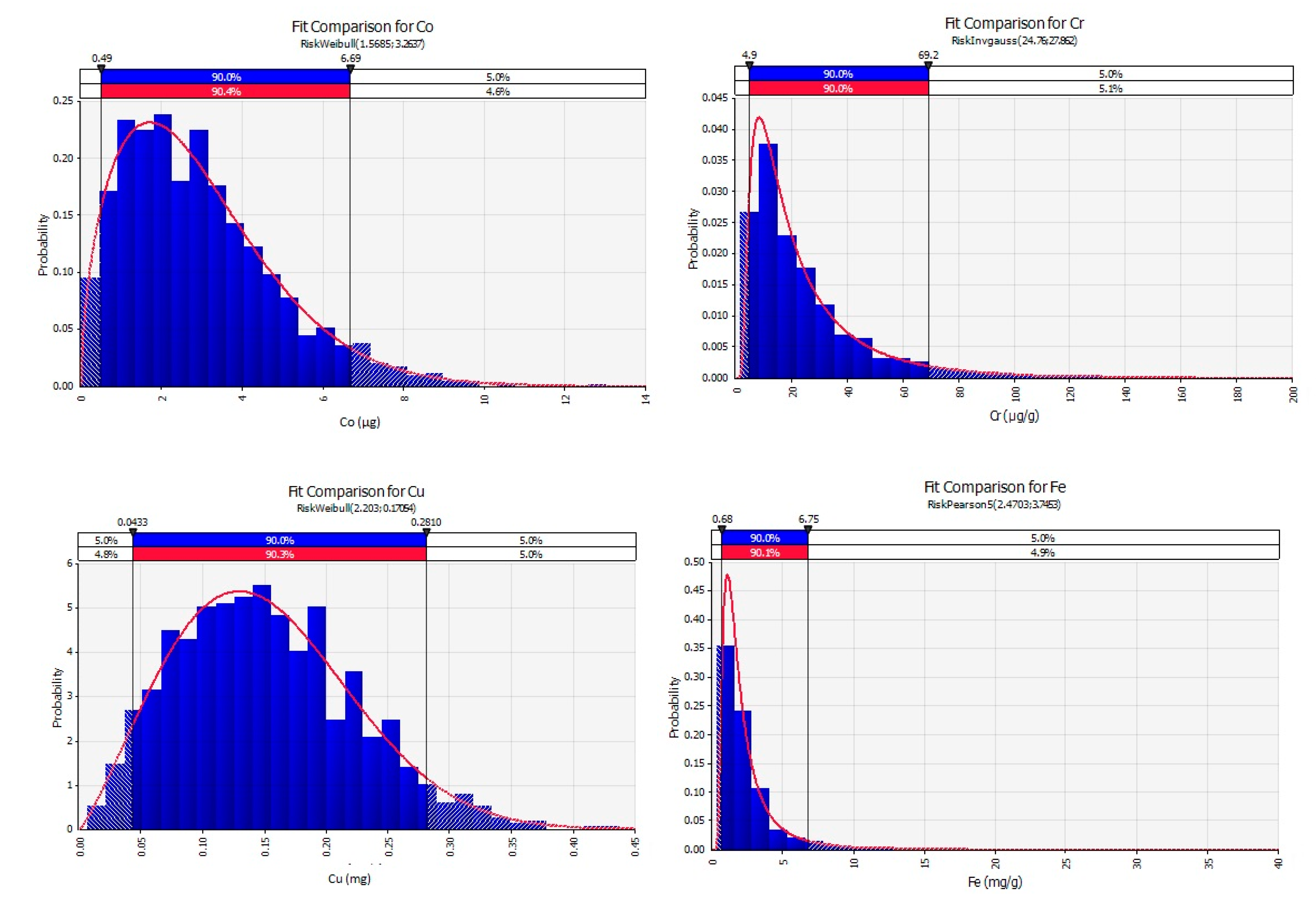

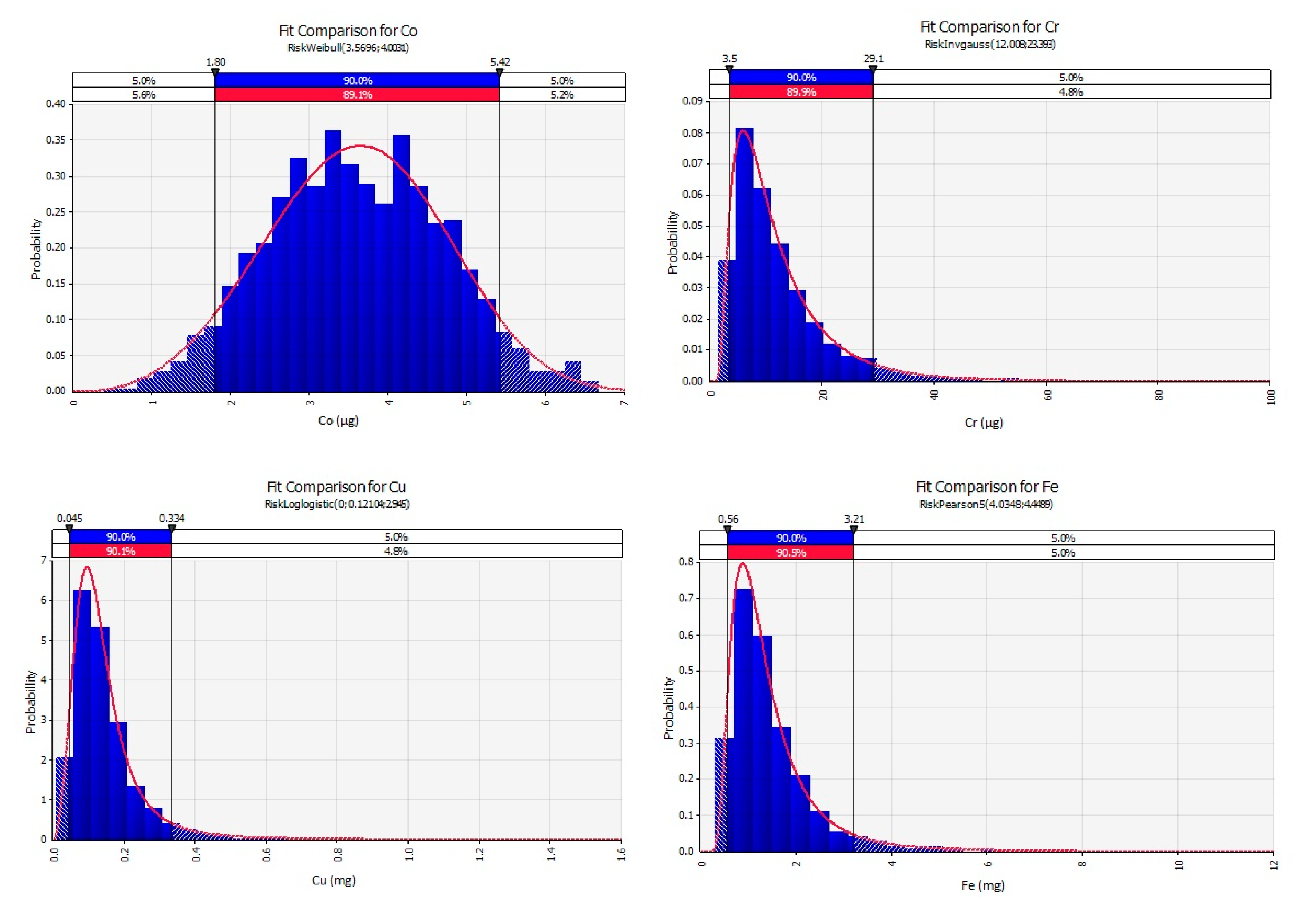

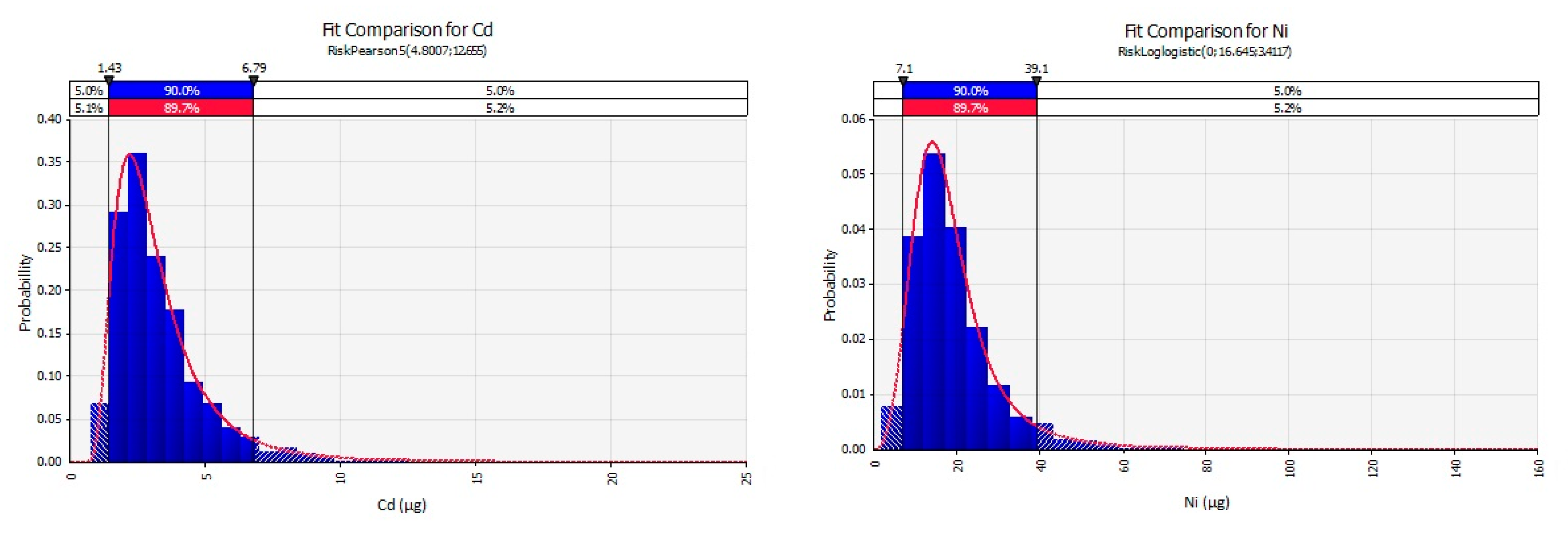
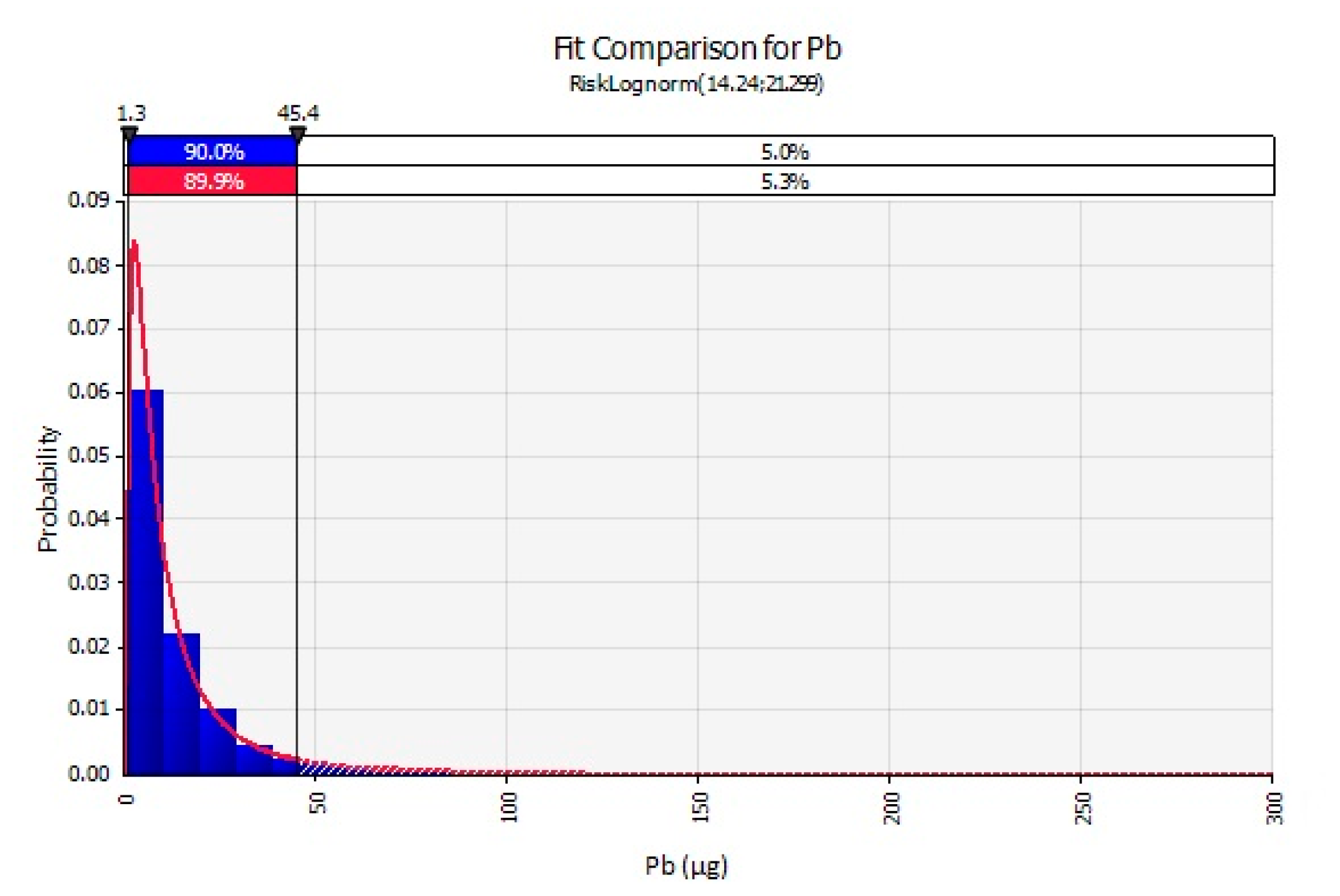
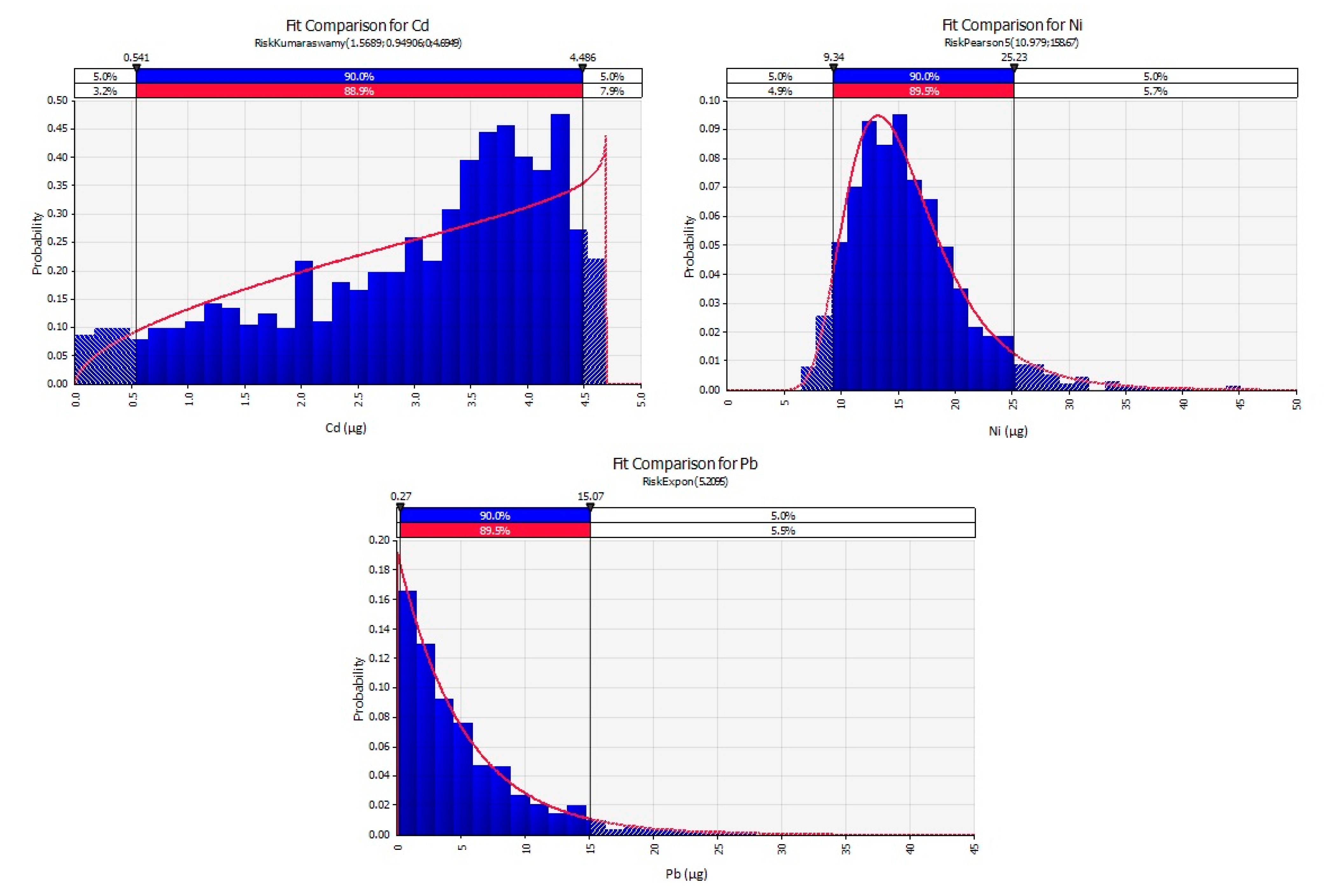
| Cd (λ = 228.8 nm) | Co (λ = 240.7 nm) | Cr (λ = 357.9 nm) | Cu (λ = 324.8 nm) | Ni (λ = 232.0 nm) | Pb (λ = 283.3 nm) | ||||||||
|---|---|---|---|---|---|---|---|---|---|---|---|---|---|
| Step | T (°C) | t (s) | T (°C) | t (s) | T (°C) | t (s) | T (°C) | t (s) | T (°C) | t (s) | T (°C) | t (s) | Argon Flow (L/min) |
| Drying | 85 | 5 | 85 | 5 | 85 | 5 | 85 | 5 | 85 | 5 | 85 | 5 | 0.3 |
| 95 | 40 | 95 | 40 | 95 | 40 | 95 | 40 | 95 | 40 | 95 | 40 | 0.3 | |
| 120 | 10 | 120 | 8 | 120 | 20 | 120 | 10 | 120 | 10 | 120 | 10 | 0.3 | |
| Pyrolysis | 300 | 5 | 750 | 5 | 1000 | 5 | 800 | 5 | 800 | 5 | 500 | 10 | 0.3 |
| 300 | 3 | 750 | 3 | 1000 | 3 | 800 | 3 | 800 | 3 | 500 | 7 | 0 | |
| Atomization | 1800 | 2.8 | 2300 | 2.8 | 2600 | 2.8 | 2300 | 2.8 | 2400 | 2.8 | 2300 | 5 | 0 |
| Cleaning | 1800 | 2 | 2300 | 2 | 2600 | 2 | 2300 | 2 | 2400 | 2 | 2400 | 4 | 0.3 |
| Element | Certified References Material (mg kg−1) | |||||||
|---|---|---|---|---|---|---|---|---|
| White Cabbage BCR-679 | Peach Leaves NIST-1547 | |||||||
| LOD (µg/g) | LOQ (µg/g) | Certified | Found | Recovery (%) | Certified | Found | Recovery (%) | |
| Cd | 0.005 | 0.016 | 1.66 ± 0.07 | 1.57 ± 0.01 | 95 | |||
| Co | 0.023 | 0.077 | 0.07 * | 0.063 ± 0.020 | 90 | |||
| Cr | 0.016 | 0.052 | 0.6 ± 0.1 * | 0.61 ± 0.03 | 102 | |||
| Cu | 0.078 | 0.260 | 2.89 ± 0.12 | 3.13 ± 0.25 | 108 | |||
| Fe | 1.09 | 3.62 | 55.0 ± 2.5 | 56.2 ± 3.0 | 102 | |||
| Mn | 0.138 | 0.459 | 13.3 ± 0.5 | 13.2 ± 0.4 | 99 | |||
| Ni | 0.056 | 0.187 | 27.0 ± 0.8 | 25.6 ± 0.9 | 95 | |||
| Pb | 0.048 | 0.150 | - | - | - | 0.869 ± 0.018 | 0.883 ± 0.073 | 102 |
| Zn | 1.20 | 4.84 | 79.7 ± 2.7 | 78.2 ± 3.0 | 98 | |||
| Co (µg/g) | Cr (µg/g) | Cu (µg/g) | Fe (µg/g) | Mn (µg/g) | Zn (µg/g) | |
|---|---|---|---|---|---|---|
| Conventional | ||||||
| Farm I | ||||||
| Brassica rapa (turnip greens) | 0.23 ± 0.10 | 2.41 ± 1.50 | 11.3 ± 3.8 | 223 ± 133 | 56.0 ± 20.1 | 38.9 ± 23.1 |
| Brassica rapa (turnip tops) | 0.14 ± 0.04 | 0.87 ± 0.59 | 8.06 ± 3.80 | 71 ± 22 | 24.2 ± 9.9 | 29.9 ± 9.1 |
| Eruca vesicaria | 0.39 ± 0.08 | 7.17 ± 0.40 | 8.19 ± 1.73 | 539 ± 324 | 34.8 ± 8.6 | 37.1 ± 5.0 |
| Farm II | ||||||
| Brassica rapa (turnip greens) | 0.28 ± 0.12 | 2.06 ± 0.98 | 7.54 ± 1.55 | 194 ± 75 | 110.8 ± 60.6 | 22.9 ± 4.7 |
| Brassica rapa (turnip tops) | 0.16 ± 0.08 | 0.52 ± 0,21 | 4.56 ± 2.27 | 60 ± 14 | 25.5 ± 13.3 | 25.1 ± 6.2 |
| Eruca vesicaria | 0.26 ± 0.09 | 3.29 ± 1.72 | 9.33 ± 1.30 | 413 ± 175 | 33.2 ± 8.0 | 34.2 ± 4.5 |
| Sinapis alba | <LOQ | 0.51 ± 0.03 | 5.57 ± 0.24 | 153 ± 32 | 18.7 ± 0.7 | 25.9 ± 3.5 |
| Organic | ||||||
| Brassica rapa (turnip greens) | 0.22 ± 0.06 | 1.20 ± 0.66 | 7.39 ± 1.79 | 105 ± 63 | 100.4 ± 38.9 | 24.4 ± 3.3 |
| Brassica rapa (turnip tops) | 0.19 ± 0.06 | 0.48 ± 0.24 | 9.04 ± 6.33 | 72 ± 43 | 24.8 ± 6.6 | 31.2 ± 5.9 |
| Eruca vesicaria | 0.44 ± 0.11 | 5.17 ± 2.25 | 10.2 ± 1.1 | 700 ± 207 | 48.1 ± 9.8 | 33.0 ± 3.0 |
| Sinapis alba | <LOQ | 0.26 ± 0.08 | 5.97 ± 1.56 | 68 ± 11 | 17.8 ± 2.4 | 23.8 ± 3.2 |
| Cd (µg/g) | Ni (µg/g) | Pb (µg/g) | |
|---|---|---|---|
| Conventional | |||
| Farm I | |||
| Brassica rapa (turnip greens) | 0.28 ± 0.16 | 1.56 ± 1.11 | 0.99 ± 0.80 |
| Brassica rapa (turnip tops) | 0.12 ± 0.03 | 0.81 ± 0.32 | 0.90 ± 0.88 |
| Eruca vesicaria | 0.72 ± 0.10 | 3.99 ± 1.47 | 3.40 ± 0.61 |
| Farm II | |||
| Brassica rapa (turnip greens) | 0.19 ± 0.06 | 1.39 ± 0.91 | 0.62 ± 0.37 |
| Brassica rapa (turnip tops) | 0.13 ± 0.03 | 1.02 ± 0.21 | <LOQ |
| Eruca vesicaria | 0.48 ± 0.05 | 1.76 ± 0.48 | 0.55 ± 0.07 |
| Sinapis alba | 0.23 ± 0.01 | 0.21 ± 0.03 | 0.16 ± 0.02 |
| Organic | |||
| Brassica rapa (turnip greens) | 0.18 ± 0.05 | 1.02 ± 0.46 | 0.33 ± 0.23 |
| Brassica rapa (turnip tops) | 0.12 ± 0.05 | 0.85 ± 0.22 | <LOQ |
| Eruca vesicaria | 0.54 ± 0.04 | 2.55 ± 0.71 | 0.91 ± 0.39 |
| Sinapis alba | 0.07 ± 0.01 | <LOQ | 0.45 ± 0.31 |
Publisher’s Note: MDPI stays neutral with regard to jurisdictional claims in published maps and institutional affiliations. |
© 2021 by the authors. Licensee MDPI, Basel, Switzerland. This article is an open access article distributed under the terms and conditions of the Creative Commons Attribution (CC BY) license (http://creativecommons.org/licenses/by/4.0/).
Share and Cite
Cámara-Martos, F.; Sevillano-Morales, J.; Rubio-Pedraza, L.; Bonilla-Herrera, J.; de Haro-Bailón, A. Comparative Effects of Organic and Conventional Cropping Systems on Trace Elements Contents in Vegetable Brassicaceae: Risk Assessment. Appl. Sci. 2021, 11, 707. https://doi.org/10.3390/app11020707
Cámara-Martos F, Sevillano-Morales J, Rubio-Pedraza L, Bonilla-Herrera J, de Haro-Bailón A. Comparative Effects of Organic and Conventional Cropping Systems on Trace Elements Contents in Vegetable Brassicaceae: Risk Assessment. Applied Sciences. 2021; 11(2):707. https://doi.org/10.3390/app11020707
Chicago/Turabian StyleCámara-Martos, Fernando, Jesús Sevillano-Morales, Luis Rubio-Pedraza, Jesús Bonilla-Herrera, and Antonio de Haro-Bailón. 2021. "Comparative Effects of Organic and Conventional Cropping Systems on Trace Elements Contents in Vegetable Brassicaceae: Risk Assessment" Applied Sciences 11, no. 2: 707. https://doi.org/10.3390/app11020707
APA StyleCámara-Martos, F., Sevillano-Morales, J., Rubio-Pedraza, L., Bonilla-Herrera, J., & de Haro-Bailón, A. (2021). Comparative Effects of Organic and Conventional Cropping Systems on Trace Elements Contents in Vegetable Brassicaceae: Risk Assessment. Applied Sciences, 11(2), 707. https://doi.org/10.3390/app11020707





